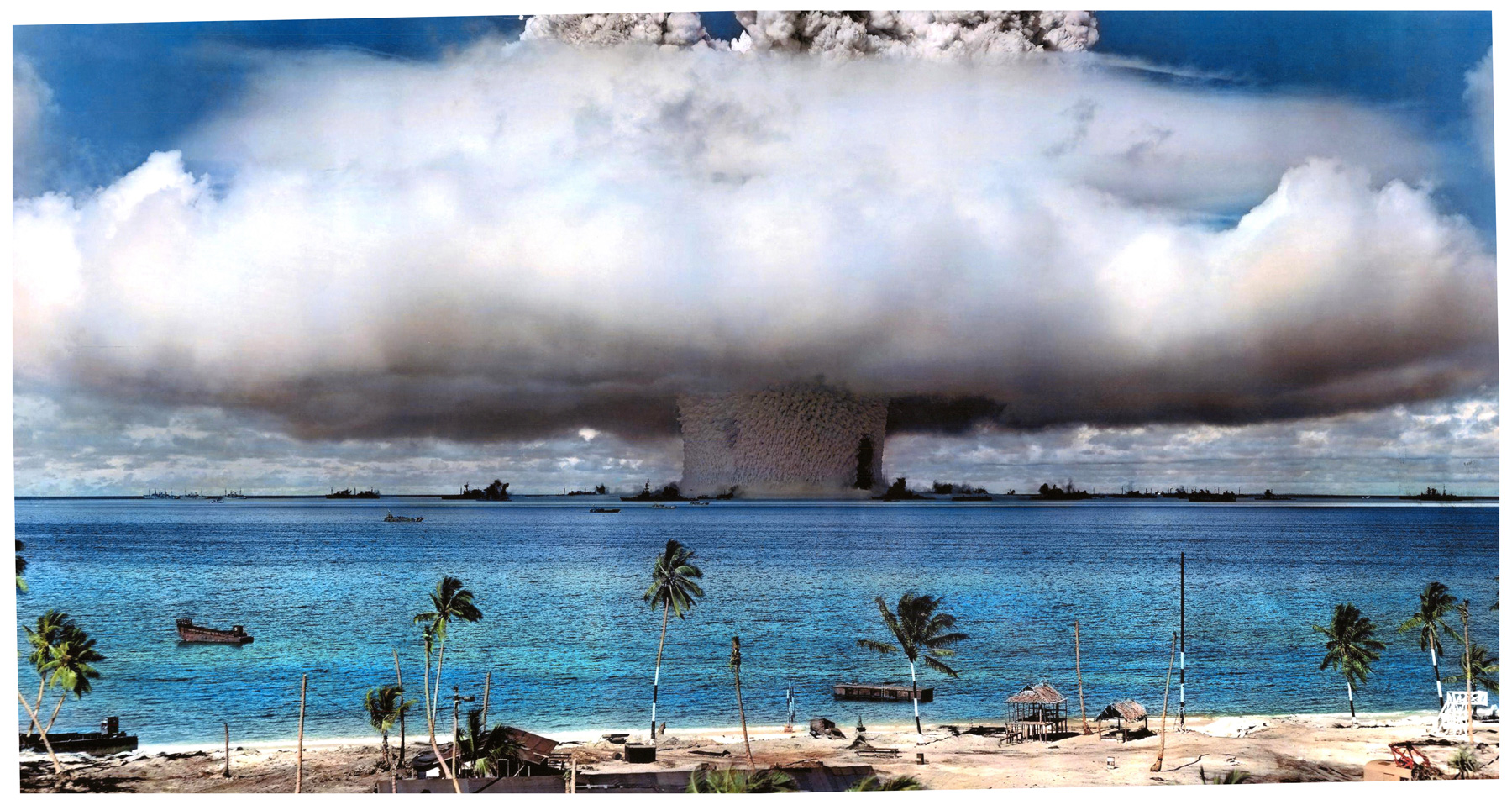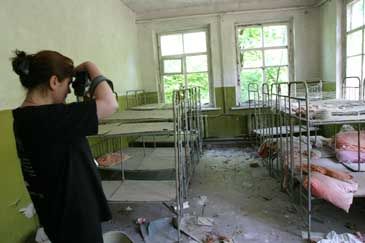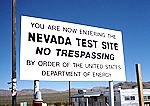
A lot has changed since July 16th 1945, when the first atomic explosion ever was witnessed by scientists and other spectators near Alamogordo, New Mexico. The ‘Trinity Test’ inaugurated the nuclear-era, which has dominated world politics up to the present day.
The spectators, consisting of a selective group of researchers and military, watched the event with mixed feelings. On the one hand the fascinating sight of the world’s largest bomb being detonated in front of their very eyes was the experience of a lifetime, but on the other it demonstrated the immense destruction mankind was capable of. J. Robert Oppenheimer, scientist and one of the developers of the Atomic bomb, later said that a quote deriving from the Hindu scripture the Bhagavad-Gita came to his mind: “I am become death, the destroyer of worlds.”
This gaze at a nuclear site would be the first of many. From that moment on, the amount of people ‘lucky’ enough to come close to an atomic explosion increased with every detonation, although the A-bomb was still kept out of the safe lives of the average world citizen (Hiroshima, Nagasaki and the nuclear tests on the Bikini Atoll being some cruel exceptions), who only had an idea of what the explosion looked like, thanks to television broadcasting and photographs.
During the Cold War the fear for a nuclear war reached its peak, making the A-bomb a daily threat to many households. Even though the nuclear arms race nowadays can still be a hot topic, the Cold War mass hysteria has come to an end, and it’s time for the tourists to explore the places and spaces that fed their fear for so many years.
There is a growing interest for visiting atomic test-sites and post-nuclear-areas. In trying to grasp tourist’s motivation in the selection of these destinies, this article will try to give an explanation for this phenomenon by discussing some of the most popular (ex-) nuclear attractions.
Tourism to nuclear-war and -disaster sites
For ages people have been drawn towards danger and geographical spaces where horrible events took place. The act of travelling to places were terrible things happened is described by Siegenthaler (2000) in various terms: ‘dark tourism’, ‘war tourism’ or ‘thanatourism’. It is interesting that in Rojek’s (1997: 62) description of so-called ‘Black Spots’, the notion of the afterlife of a nuclear tragedy as a tourist destination is left out completely .
In this article I will solely make use of the term ‘nuclear tourism’, to make a clearer argument and to avoid any possible confusion or mix-up by not using any of the other terms, even though in my opinion this term doesn’t in any way annul the other ones.
What I understand by nuclear tourism, is pretty much laid out in the introductory lines of The Bureau of Atomic Tourism : “[The BAT] is dedicated to the promotion of tourist locations around the world that have either been the site of atomic explosions, display exhibits on the development of atomic devices, or contain vehicles that were designed to deliver atomic weapons.”
Although The BAT is a place for virtual atomic traveling, the description provided by the ‘bureau’ is without a doubt a valid one for nuclear tourism in real life. Tourism to such sites as Hiroshima and Nagasaki was vastly developed after the WW II: “As early as 1949, Hiroshima memorials drew tourists to the area around the ruined Industrial Promotion Hall (now usually referred to as the Genbaku dômu, or the Atom Bomb Dome) […]” (Siegenthaler 2002: 1111).
These sites represented the end of WWII as they still do up to this day. It is very likely that the tourists in the early days didn’t have the kind of detailed information on possible radiation that we have today. The dangers of nuclear tourism weren’t that well known and it wasn’t as institutionalized as it is now, as the vast majority of tourists just after WWII consisted of Japanese tourists, although
“[…] feeling[s] of resentment on the part of hibakusha, the term most often used for survivors of the bombings, toward political and commercial activities related to the atom bombs […]”.
According to Siegenthaler's article, this resentment of commercial activities such as tourism is also present under the survivors of the bombing in Nagasaki. The Japanese government, however, started rapidly with evolving this new type of tourism to an enterprise that’s still flourishing up to this very day.
The question is: What attracts tourists to these sites? In the case of Hiroshima, there is no interesting pre-A-bomb past to be visited, so that tourism is focused almost entirely on the bombing.
The official website for tourism to Hiroshima places the ‘A-Bomb Dome’ (which was registered as a UNESCO World Cultural Heritage in 1996) number one on the list of ‘recommended sightseeing tours’ . The way in which the ‘Peace Memorial Museum’ is described, reminds the visitor of other sites of mass genocide, like Auschwitz for example: “[…] exhibited articles left by atomic bomb victims and photos/data showing the horrors of the atomic bombing.”
The crucial difference between Hiroshima and Nagasaki is that the pre-A-bomb history of the latter plays a far bigger role in tourist visits. In Hiroshima’s case, the bombing is seen as the single most important event. In the description given by the tourist information of the Hiroshima Navigator website, it is clear that everything is situated around the dropping of the bomb:
“The exhibits tell us not only about Hiroshima's history before and after the atomic bombing, but also about the situation with regard to the nuclear age.”
The feeling that emerges from this website for tourist information, is that of the bombing being ‘imposed’ on the innocent inhabitants, giving special interest to the location and geography (which is usually the case with tourist attractions) with a touch of sentimentality which allows tourist to really ‘feel’ the fear and anxiety caused by the original event.
The A-Bomb Dome is the only vivid reminder of the bombing, because the reconstruction of the city started rapidly after the initial destruction. So the idea of Hiroshima as a historical marker and the stress on the fear amongst the innocent citizens plays a big role in constructing the nuclear tourist experience, where the ever present threat of lingering fallout gives the trip that extra thrill.
An important factor of nuclear-bomb sites is that it takes a long time for the radioactive fallout to disappear completely. In Hiroshima and Nagasaki for example, there are still accounts of inhabitants suffering from the effects of radiation. Another tourist destination, uninhabited up to this day due to life-threatening radiation levels, is the Bikini Atoll. Tourism at Bikini started in 1996; when the waters were found save for diving.
It is still not possible, however, to eat products produced by the islands because they still contain a certain amount of radioactivity , although the last United States nuclear test was realized back in 1958: “The soil, however, contains radioactive cesium, which concentrates in the plants and their fruit. Therefore you can’t eat anything that grows there; all food is imported.” It would seem clear that a diving tour would not be completely safe, althoughthe possible danger of exposure by being near the Atoll is never mentioned .
The way in which diving tourism is presented by the official website is quite extraordinary: “Been There? Done That? Are you a diver looking for an extraordinarily new experience? Then welcome to our new fantasy… Bikini Atoll’s underwater fleet. We will rock your underwater world.”
The visitor is promised a somewhat irregular and indeed very special site that is incomparable with other diving experiences, and therefore has a special price . There is no emphasis or extra reassurance on part of the promoters that there is no danger of exposure of any kind. Does this mean the information is hidden from the general public? No, quite the opposite, everybody with some knowledge in world history will remember the Bikini Atoll as a nuclear testing ground only, and this is precisely what attracts tourists. It is safe to say then that for the nuclear tourist the attraction to the history of a place combined with the possible danger eventually creates the ultimate trip.
One of the latest ex-nuclear disaster sites to become a nuclear tourism destination is Chernobyl, as is the Nevada desert testing ground, where the vast majority of U.S. A-bomb tests took place. In these two particular cases, the possibilities of being exposed to large amounts of radiological material are practically inescapable. According to scientists the odds of taking a somewhat nasty souvenir with you after visiting one of these highly contaminated sites is more than likely: “On the tour [of the Nevada testing areas] ,[…], you could inhale microscopic specks of plutonium […] One-millionth of a gram of plutonium inhaled gives a 100 percent probability of lung cancer”(Wiener 1997: 3).

Still they’re enough tourists visiting these sites without really being worried about the possible consequences. The only time for example, that the Guardian journalist (2004) felt “[…] a little uncomfortable about being there […]”, was when standing in front of one of the Chernobyl nuclear reactors, which indicates that only the immediate confrontation with the cause of the accident will bring about thoughts of fear or discomfort.
While the bus tour at the Nevada test-areas is promoted by the U.S. government to attract more visitors, there is no promotion whatsoever for Chernobyl by the Ukrainian Government: “[…] Kiev based tour agencies have begun to offer all-inclusive day trips to the scene […]” (Guardian Unlimited 2004). The differences between the two sites are substantial in that respect: the former was merely a testing ground for atomic weapons, while the latter was the scene of one of the most horrific nuclear accidents in the twentieth century. The Ukrainian government has nothing to be proud of, so to speak. Just by mentioning the name ‘Chernobyl’ vivid memories come to those who were old enough to remember the time the accident occurred. No wonder, one would say, that some people would like to go and see the disaster-site for themselves. It is in the case of Chernobyl, where the ‘nuclear tourist gaze’ takes full effect, because of the fact that the original inhabitants still haven’t returned to their homes, while their homes and households are still there, displaying the most terrible moments of the lives of these inhabitants experienced: “Towns and villages that were evacuated in the days following the disaster are the biggest attraction” (Parfitt 2004: 2).
Lisle (2000) also notes that “[…] the boundary […] of contemporary war tourism is that between curiosity and voyeurism.” which is especially the case in the example of Chernobyl tourism. Nearly all commentaries on Chernobyl that try to express the tourist experience use the same terms: ghostly, bleak, terrifying, deadly. The great difference with a tourist destination like Bikini Atoll (also uninhabited up to this day, but without a rapid evacuation) is that the evacuation of the population of Chernobyl is still consumable for the nuclear tourist gaze.

While the Bikini Atoll underwater fleet was sunk on purpose, the human suffering in the case of Chernobyl was ‘an accident’ and is therefore much more visible and thus imaginable for the nuclear tourist, reliving the chaotic final moments of the fleeing inhabitants. The abandoned households enable most tourists to really identify with the victims, and the thrill of the nearness of the same danger still forming a danger to the tourists themselves is the key factor in creating the ultimate ‘nuclear experience’.
Conclusion
People have always been attracted to travel to dangerous places, although the motives in the case of nuclear tourism somewhat differ. Originally, in the case of Hiroshima and Nagasaki, nuclear sites functioned as a remembrance of the final days of WWII. Nowadays the old Cold War nuclear testing grounds and nuclear accident-sites are vastly becoming tourist destinations.
Judging the amount of promotional material, nuclear tourism is becoming more popular, although the visit of nuclear sites does not come cheap and is hard to find records on the exact amount of tourists visiting these sites. The economic benefits play a big role in most governmental promotion, for in the eyes of some nuclear tourism must be the perfect solution to the question how to deal with these uninhabitable –and now, since the testing of nuclear arms has stopped in many places, no longer profitable- places. In some cases, as in that of the Bikini Atoll as a post-atomic diving resort, nuclear tourism generates the only form of income for the local government.

As some tourists tend to go for more ‘extreme’ sites, the fact that they’re possibly exposed to high levels of radiation is simply considered part of the package. This constant threat and eminent danger increases the thrill of nuclear travel, because without the radiation being visible it’s never absent in the experience of the nuclear tourist, and therefore gives a special –and usually more frightening- ‘flavour’ to a site. This is especially the case at sites like Chernobyl and the Bikini Atoll, where the original inhabitants still haven’t returned due to these life-threatening factors.
Nuclear tourists tend to go for the ultimate thrill, wherein the possible presence of radioactive material constitutes part of the excitement. The nuclear tourist gaze, which is brought to its full effectiveness when voyeuristically consuming a deserted place like Chernobyl, allows tourists to see where life stops and nuclear tragedy begins. The fact that they have to rush to avoid long-lasting exposure, adds to the experience and enables tourists to imagine and relive the nuclear tragedy to its full extent, so that in the end these tourist, fearless of radioactive fallout as they may be, can proudly say: “I am become a nuclear tourist, the visitor of atomic destruction.”
Sources:
Degroot, Gerard. (no date). The Afterlife of a Nuclear Test Site: Cross Current, appears as Ebsco full text: not paginated.
Hijiya, James A. (2000). The Gita of Robert Oppenheimer: Proceedings of the American Philosophical Society, Vol. 144, No. 2: 123-167.
Lennon, John J. and Malcolm Foley. (1999). Interpretation of the unimaginable: The U.S. Holocaust Memorial Museum, Washington D.C., and ‘Dark Tourism’: Journal of Travel Research, August 1999.
Lisle, Debbie. (2000). Consuming danger: Reimagining the War/Tourism divide: Alternatives: Social Platform, appears as Ebsco full text: not paginated.
Niedenthal, Jack. (2002). For the good of mankind: a History of the People of Bikini and their Islands. Hawaii: Bravo.
Siegenthaler, Peter. (2002). Hiroshima and Nagasaki in Japanese guidebooks: Annals of Tourism Research, Vol. 29, Issue 4: 1111-1137.
Wiener, John. (1997). Cold War tourism, western style: The Nation, October 6: not paginated.